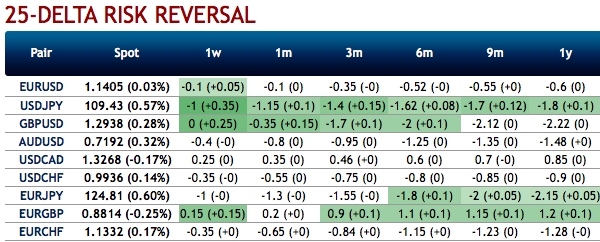CAD seasonals remain bearish, given the currency’s tendency to weaken into year end and base around the end of January. We jotted down quite a few driving forces of CAD along with the OTC updates and options strategy of USDCAD.
As the BoC’s probability of its hiking cycle over the next two years, whereas the Fed’s end of its own cycle next year, one can expect the CAD to appreciate.
CAD is sensitive currency crude, we run you through some key intricacies of crude inventories. Non-OPEC oil supply growth in 2018 - including the State of Qatar is estimated at 2.61 mb/d, an upward revision of 0.05 mb/d from the previous month’s assessment to average 62.06 mb/d. This compares to an average of 60.03 mb/d excluding Qatar liquids supply in the December MOMR. The US, Canada, Russia, and Kazakhstan are seen to be the main growth drivers, while Mexico and Norway are estimated to show the largest declines.
Non-OPEC oil supply growth in 2019 was revised down by 0.06 mb/d to 2.10 mb/d and is now forecast to average 64.16 mb/d for the year. This was mainly due to a downward revision in Canada’s supply forecast. The US, Brazil, Russia and the UK are projected to be the main drivers for this year’s growth, while Mexico and Norway are expected to see sizeable declines, along with a mild YoY decline of 0.05 mb/d in Canada. OPEC NGLs – excluding Qatar – in 2018 and 2019 are now expected to grow by 0.04 mb/d and 0.11 mb/d, respectively, to show lower average levels of 4.98 mb/d and 5.09 mb/d.
In December 2018, OPEC crude oil production decreased by 751 tb/d to average 31.58 mb/d, according to secondary sources of OPEC.
USDCAD OTC indications and options strategies:
At spot reference around 1.36 level, diagonal call options spreads were advocated a few days ago foreseeing both downswings in the near-term and the major uptrend. As you could observe the underlying spot of USDCAD has dipped below 1.33 level, short calls are most likely to expire worthless, so that the option writer can be rest assured with the initial premiums received.
Contemplating above driving forces, we continue to advise diagonal call spreads as preferred option structures given elevated skew and favorable cost reduction.
At spot reference: 1.3270 levels, we execute USDCAD 1m/2w call spread with strikes of 1.3125/1.36 for a net debit.
The rationale: 1M ATM IVs are trading between 6.30% - 6.75%, skews are also suggesting the odds on OTM call strikes up to 1.35 levels at this juncture. Please notice bullish neutral risk reversals that signal upside risks in the risk-neutral distribution of returns. Also, the IV curve is at, or slightly decreasing, with maturity.
Favor optionality to directional trades. We are inclined to position for a directional call spreads, as calling the bottom is quite difficult and adding naked spot exposure is risky at the moment.
Maintain the net delta of the position above 40% and shorting the upper leg call (OTM strikes) likely to reduce the cost of the ITM call by almost close to 20-25%.
Maximum gain is achievable when underlying spot FX move above OTM strike with ideal risk-reward.
By shorting the out-of-the-money call, the options trader finances the cost of establishing the bullish position but forgoes the chance of making a large profit in the event that the underlying asset price skyrockets. Source: OPEC, Sentrix, Saxobank
Currency Strength Index: FxWirePro's hourly CAD spot index is flashing at 3 levels (which is neutral), hourly USD spot index was at -3 (neutral) while articulating at (13:33 GMT).
For more details on the index, please refer below weblink: http://www.fxwirepro.com/currencyindex



 Core- Bitcoin Layer 1 Blockchain with Satoshi plus novel consensus mechanism
Core- Bitcoin Layer 1 Blockchain with Satoshi plus novel consensus mechanism  FxWirePro- Gold Daily Outlook
FxWirePro- Gold Daily Outlook  FxWirePro- Gold Daily Outlook
FxWirePro- Gold Daily Outlook  FxWirePro- Gold Daily Outlook
FxWirePro- Gold Daily Outlook  FxWirePro- Gold Daily Outlook
FxWirePro- Gold Daily Outlook  Flare - EVM based Layer 1 Blockchain
Flare - EVM based Layer 1 Blockchain  FxWirePro- Gold Daily Outlook
FxWirePro- Gold Daily Outlook  FxWirePro- Gold Daily Outlook
FxWirePro- Gold Daily Outlook  Impact of Iran-Israel conflict on Stocks, Gold and Bitcoin
Impact of Iran-Israel conflict on Stocks, Gold and Bitcoin  FxWirePro- Gold Daily Outlook
FxWirePro- Gold Daily Outlook 






























